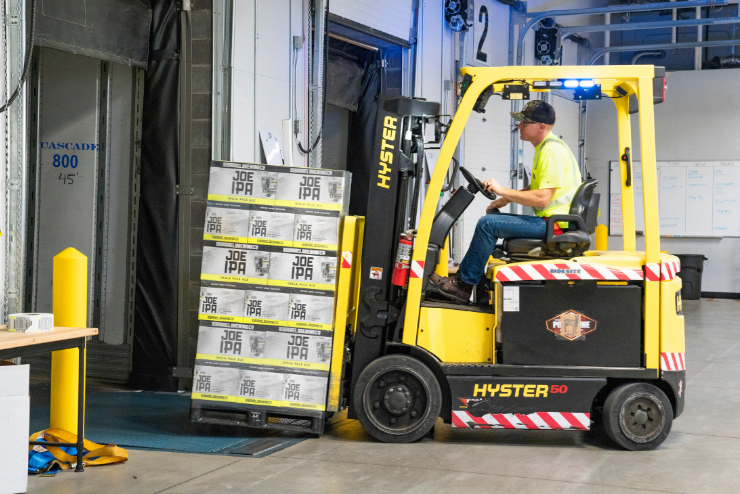The Unsung Hero That Completes The Supply Chain
- Allen Czermak
- Mar 27, 2022
- 6 min read
Updated: Mar 29, 2022
Boxes don't move themselves...
Especially large freight, such as ISO containers, it takes an intermodal network to accomplish this, and drayage is a vital part of it. An example of drayage is transporting freight containers from an ocean port to a land destination. Aka, "The first mile." The unsung secret is drayage optimization, in which we can master the first mile, the most important mile.
You may be thinking, what's the big challenge about getting the first mile accomplished? Well, there is no intermodal without drayman; it's what makes the first mile, the last mile, and the crossover between transportation modes possible. But first, let's revisit what intermodal means for the industry and the importance of intermodal trucking.

Intermodal is often directly referring to moving shipping containers in various modes of transportation. These containers are built and designed for intermodal transport from point A to point B or city port to a warehousing facility. They can be moved by truck or rail and are essential for large quantities of supplies to be transported. In addition, the workers load and unload these materials into whatever mode is required for the cargo's transportation.
Intermodal transportation companies are the arteries of the supply chain movement within the United States. It is done with precision and as efficiently as possible to cut our vehicle fleet's carbon footprints and fuel costs, not to mention the drayage expense which is often a significant cost factor in the first-mile delivery charge. Various shipment container sizes are commonplace and known under different names, whether small or large containers; drayman experience handling them all. Cargo, freight, and ISO containers, or they are sometimes simply called a "shipping containers", but the majority are considered "dry freight" or "general purpose" freight. Hence, it can be complicated to train those who move these containers to sort and stack them efficiently. Intermodal trucking is about the quality movement and coordination of containers between transportation modes. The drayage service is the intermodal's cartilage between the bones of the entire body of operations.
What Is Drayage, And Why Is It Important?
With millions of containers moving in and out of seaports, there's a lot of necessary handling that requires drayage services. No matter the inland destination: rail terminals, warehouses, or various types of receivers the transported supply needs specific equipment, expertise, and carriers in all these instances.
That's drayage!
Many in the transportation industry have direct experience in working with drayage services. In most cases, drayage services and companies only work directly with freight receivers and carriers. Essentially, the freight receiver acts as a representative for each client. They are educated on freight costs and help clients understand the delivery rates and fees. Drayage service companies will also work with intermodal partners to handle all customer service issues from the beginning to end of a shipment.
That's why drayage is so essential. Customers can wait months for their supplies to be docked and unloaded via intermodal shipping companies. It's vital to be affiliated with a trusted logistics provider to ensure the shipping container is delivered to its final destination as soon as possible!
Some recent drayage innovations are smart containers that offer real-time monitoring so customers can quickly locate cargo. This also provides critical information to ensure that the cargo does not just sit around the ports and accumulate and added terminal fees.
A Brief History of Drayage Shipping
Historically, a drayage service was known for short-haul transportation on a horse-drawn cart. From a collection of small parcels to bulk cargo, these goods were picked up from river ports, seaports, and train delivery terminals. As the years went on and the industry became more sophisticated, drayage evolved into more types of transportation for various container sizes.
How containers move and attach to each other was a part of the innovation that propelled the United States supply chain ecosystem. A drayage chassis is an excellent example of this. It's a special trailer or undercarriage used to carry ocean carriers over land. A chassis is necessary for a shipment traveling by truck. A "container chassis," also called intermodal chassis or skeletal trailer, is a semi-trailer that an intermodal container can be mounted onto for travel. Truckers use chassis to deliver containers between ports, railyards, container depots, and shipping facilities.

When a container needs to be hauled many miles across the highway, the chassis frame and wheels are what the container is attached to for transport. These are specially designed and strengthened for the on-off crane movement and have a locking mechanism to secure the container for a short or long dray haul. The next wave of innovation to help in this area will be the advancing and eventual deployment of electric vehicle technologies for supply chain optimization. Last June, TechNavio reported the global drayage services industry will grow $2.9 Billion in USD from 2021 to 2025; other critical findings in their report indicate market growth of CAGR (compound annual growth rate) by 2%. As manufacturing grows worldwide, so will drayage services, and their communities will become more prominent and play a vital role in the future.
Today's new and improved drayage services will also continue to evolve to meet the commonplace supply chain challenges while implementing new and state-of-the-art ways to surpass them. Electric drayage trucks and other heavy machinery upgrades will be vast and impactful for everyone involved in the supply chain.
Ways To Optimize First Mile Drayage Services
While long-haul trucking requires many miles against a battery that powers an electric vehicle, the bigger the battery, the less cargo it can transport, partly due to spacing and regulatory compliance. Drayage innovation is, therefore, a unique opportunity for the industry to implement some of the newer advancements in the industry and avoid the speed bumps that come along with such innovations.
As electric vehicle technology continues to transform and innovate in the larger metropolitan areas, electric trucks are gearing up to become a future standard. It won't happen fast, as the ways we power these electric fleets will take time to build out.

Building the centralized charging infrastructure will not be easy, but significant investments and industry focus are making headway. A substantial portion of drayage vehicles can bypass the challenge of finding an appropriate balance between weight versus power capacity in electric drayage vehicles. With drayage shipping often limited in range requirements, they can service their areas within current battery-powered constraints and be the optimal starters to enter the electric shipping solutions world, especially in the large port facilities.
Essentially, this would be an excellent fit for early model electric trucks instead of focusing on shorter hauls to cut down on what's often the most expensive part of a shipping containers movement. An example of how this is being worked on today is by Embark's recent pilot program. In conjunction with HP Inc., they utilize BYD electric trucks to complete first- and last-mile deliveries via Embark transfer points in Los Angeles testing areas. It is best suited for drayage operations and cities focused on eliminating their carbon footprint.
As Assembly Majority Leader Eloise Gomez Reyes stated, "We're excited to see innovative companies like HP, Embark, and BYD step up to help the State of California meet its ambitious emission reduction goals. With zero-emissions short-haul and autonomous long-haul trucks working in tandem, we're improving air quality in California's disadvantaged communities and addressing the climate crisis head-on. "
We've seen similar ways of how the industry moved toward better shipping methodologies in the past. Consider how we've changed the driver experience from a trailer dominant industry to a container dominant industry. The intermodal industry could have been described as pretty simple. But way back as the railroads expanded, the intermodal system needed to adapt to support the economies that the railroad companies were aiming for.
Of course, the changes bring challenges for its operators and the drayage community along the way. It is always by way of more (or constant) innovation that we continue to grow and support new growth, no matter the hurdles that come along for the ride.

Why Collaboration Is Key for Drayage Innovation
Simply optimizing for drivers who do the runs at the port from mode to mode requires a tremendous collaboration. For everyone to really optimize this process, they need to help their business partners optimize. This then becomes a win-win situation. So, the industry is automatically encouraged to collaborate with each other.
As can happen in any industry, the unsung get focused on last, and without any direct reasoning, in many cases, drayman get the final chorus sung as well. We owe it to the drayage workers to enhance their experience in a container world by bringing upgraded machinery and early model electrical trucks.
We still have a long way to go in the industry, but we're getting closer to a critical turning point where the new innovations will ultimately be ready to deploy, and we'll have to be prepared and willing to give it a try at the first mile.












Comments